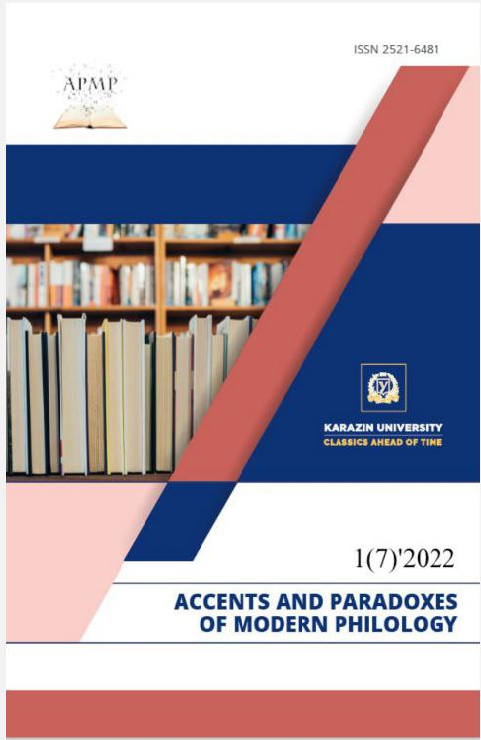ТИПИ І ФУНКЦІЇ ЗВУКОПИСУ В ЛІРИЧНИХ ВІРШАХ РАЙНЕРА МАРІЇ РІЛЬКЕ
Анотація
У статті розглянуто типи і функції звукопису в ліричних поезіях Райнера Марії Рільке. Наголошено на особливостях його поезії, присвяті мистецтву звучання слова. Зазначено, що важливими для лінгвістики в поезії Рільке є типи звукопису та його функції. Подано дефініцію звукопису як поетичного засобу, з’ясовано різницю між поняттями Lautmalerei та Klangmalerei. Акцентовано увагу на тому, що поезії Рільке властива чистота рими, крім нерівномірно наголошених рим, у яких поєднується сильне закінчення (з основним наголосом на останньому складі) зі слабким (коли останній склад утворює суфікс або інша частина словосполуки, що містить лише другорядний наголос). Окреслено різні критерії, за якими можуть розрізнятися типи звукопису. Зазначено, що за критерієм повторюваного елемента в поезії Рільке представлені найважливіші види звукопису: асонанс, алітерація, внутрішня рима та парономазія. Розглянуто естетичну та іконічну функцію поетичного твору. При аналізі іконічної функції висвітлено три її підвиди: сугестивна, ономатопеїчна та звукосемантична. Термін «функція» використовується у значенні «завдання». У статті досліджено
кожну із функцій та проілюстровано прикладами поезій Рільке. З’ясовано, що фігури звукопису у віршах Рільке характеризуються розміщенням у початковому складі,
однак можуть мати й інші позиції в слові; довгота голосних не враховується; для алітерації є нетиповою еквівалентність голосних; не виключені метатези та нерівномірне суголосся; всередині вірша, строфи та в цілому тексті відбувається як зближення, так і розбіжність фонетичних фігур; фонетичні фігури прив’язані до синтаксичних структур. Наголошено, що креативний і дієвий звукопис у поезії Райнера Марії Рільке є значним внеском у евфонію тексту та вираження його змісту. У підсумку засвідчено, що Рільке справедливо називають королем звуку в поезії.
Завантаження
Посилання
Braak, Ivo (1980) Poetik in Stichworten. Literaturwissenschaftliche Grundbegriffe. Eine Einführung; 6. Aufl. Kiel: Hirt. 324 S.
Conrad, Rudi (1985): Lexikon sprachwissenschaftlicher Termini. Leipzig: Bibliographisches Institut. 281 S. Flakowski-Janković, Martina (1993): Klangstrukturen und inhaltliche Aussage in lyrischer
Dichtung: Untersuchungen zur Phonostilistik; theoretische Grundlagen und praktische Analyse. Frankfurt am Main: Hector. 420 S. Grimm, Reinhold (1981): Von der Armut und vom Regen: Rilkes Antwort auf die soziale
Frage. Königstein/Ts.: Athenäum. 101 S.
Groß, Michael (1988): Zur linguistischer Problematisierung des Onomatopoetischen. Hamburg: Buske. 261 S.
Grümmer, Gerhard (1988): Spielformen der Poesie. Leipzig: Bibliographisches Institut. 243 S.
Jakobson, Roman (1981): Linguistics and Poetics. In: Roman Jakobson. Selected writings.
: Poetry of Grammar and Grammar of Poetry. Paris: The Hague / New York: Mouton. P. 18–51.
Kabell, Aage (1978): Metrische Studien 1: Der Alliterationsvers. München: Fink. 313 S.
Kayser, Wolfgang (1999) Kleine deutsche Versschule. 15. Aufl. Tübingen: Francke. 123 S.
Kozhevnikov, Vadim M. / Nikolaev, Petr A. (Hgg.) (1987): Literaturnyj enciklopedicheskij slovar' [= Literaturlexikon]. Moskva: Sovetskaja enciklopedija. 751 S.
Kühnel, Jürgen (1978) Untersuchungen zum germanischen Stabreimvers. Göppingen: Kümmerle. 397 S.
Küper, Christoph (1976): Linguistische Poetik. Stuttgart, Berlin [u. a.]: Kohlhammer. 148 S.
Löwenstein, Sascha (2004): Poetik und dichterisches Selbstverständnis: eine Einführung in Rainer Maria Rilkes frühe Dichtungen (1884–1906). Würzburg: Königshausen & Neumann. 282 S.
Man, Paul de (1999): Allegorii chtenija: Figural'nyj jazyk Russo, Nicshe, Ril'ke i Prusta [Allegorien des Lesens: figurative Sprache Rousseaus, Nietzsches, Rilkes und Prousts]: übers. aus dem Englischen. Ekaterinburg: Izdatel'stvo Ural'skogo universiteta. 368 S.
Mönckeberg-Kollmar, Vilma (1946): Der Klangleib der Dichtung. Hamburg: Claassen & Goverts. 81 S.
Mörchen, Hermann (1958): Rilkes Sonette an Orpheus. Stuttgart: Kohlhammer. 496 S.
Nowy, Arthur (1984): Zauber der Laute unserer Sprache. Feststellungen und Anregungen zum Umgang mit der Sprache. Stuttgart: Steinkopf. 244 S.
Pagni, Andrea (1984): Rilke um 1900. Ästhetik und Selbstverständnis im lyrischen Werk. Nürnberg: Hans Carl Verl. 182 S.
Peirce Ch. S. S. (1998): The Essential Peirce. Volume 2: Selected Philosophical Writings (1893–1913). Bloomington: Indiana University Press. 624 p.
Schulz, Hartwig (1970): Vom Rhythmus der modernen Lyrik. Parallele Versstrukturen bei Holz, George, Rilke, Brecht und den Expressionisten. München: Hanser. 160 S.
Strehle, Hermann (1956): Vom Geheimnis der Sprache: sprachliche Ausdruckslehre – Sprachpsychologie. München: Reinhardt. 201 S.
Vekshin, Georgij V. (2005): K fonostilistike porozhdenija teksta [Zur Fonostilistik der Textgenerierung]. In: Filologicheskie nauki. № 6. S. 22–31.
Weis, Hans (1941): Deutsche Sprachspielereien. München: Oldenbourg. 114 S.
Zhirmunskij, Viktor M. (1975): Teorija stiha [Verstheorie]. Leningrad: Sovetskij pisatel'. 664 S.




